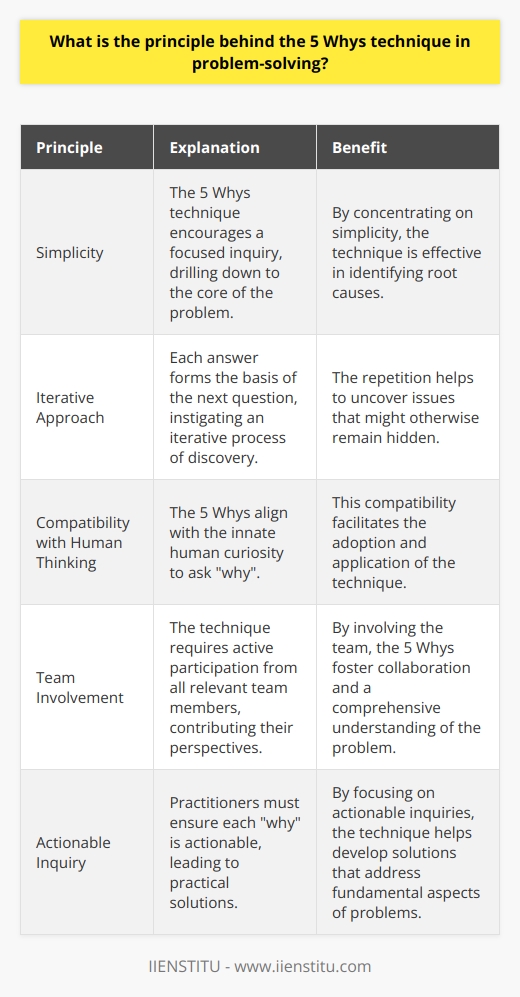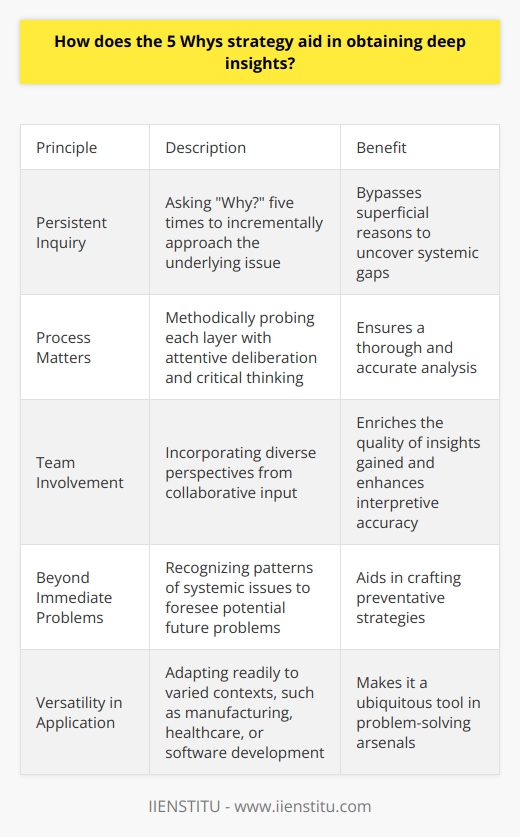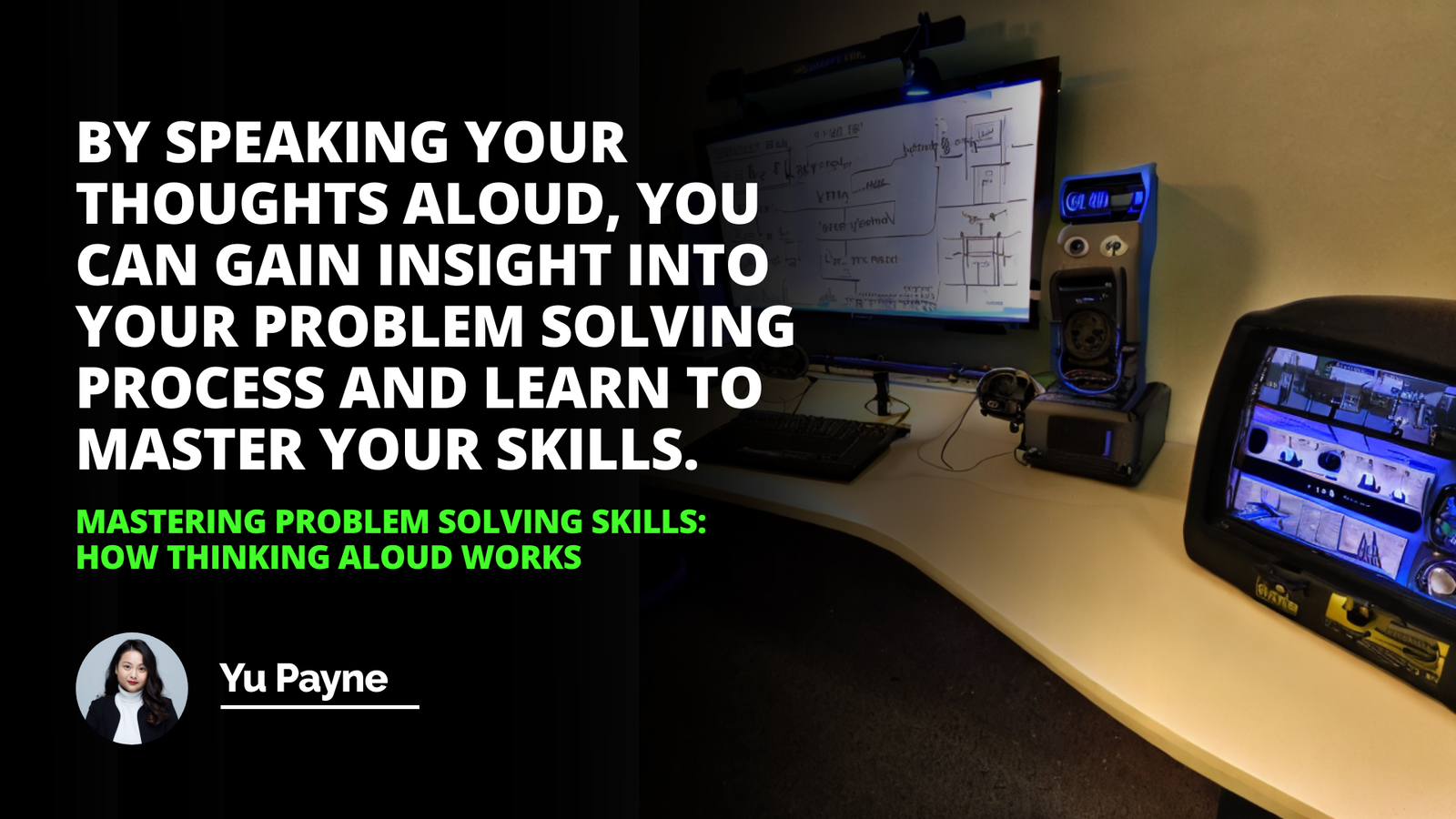
In today's rapidly evolving professional landscape, the ability to navigate complex issues with precision and insight is more crucial than ever. At the helm of essential competencies for today's leaders and innovators are problem solving and critical thinking—skills that not only enable informed decision-making but also foster a culture of persistent inquiry. This article delves into the heart of Root Cause Analysis, a pivotal component in the problem solver’s toolkit, intended to unearth underlying issues rather than symptomatic responses. Integral to this approach is the Understanding The 5 Whys, a simplistic yet profound technique designed to peel back the layers of a complication to reveal the core issue. In doing so, a practitioner equipped with deep insight can subsequently make decisions that are not just reactive but strategically forecasted for sustainability and growth.
🔊 Ready for an auditory reading experience? Just click the 'Play' button right below this text and immerse yourself in our captivating audio version. Ideal for those who prefer listening to stories, or for times when you're multitasking. Engage with our content effortlessly - one simple click is all it takes to transform your reading into listening!
Emergent from these practices are enhanced competencies that the modern professional seeks. To foster such skills as an ongoing developmental arc, educational platforms now offer opportunities such as a problem solving skills course or an online mba course, where theoretical knowledge meets practical application, preparing aspirants to become adept problem solvers in their fields. Herein, we conceptualize the journey toward mastering these skills with a focus on the practical application of The 5 Whys method, understanding its intricacies, and expanding upon it for nuanced decision-making.
Understanding The 5 Whys
Historical Context and Development of The 5 Whys Method
The origin of The 5 Whys traces back to the industrial landscapes of Japan, where it was developed within Toyota's manufacturing processes. The method was crafted as a systematic means to determine the root cause of technical complications in the assembly line. Its simplistic nature belies the depth of insight it affords, rending complex problems into basic elements easily understood and addressed by technical and management teams alike.
Description of What The 5 Whys Entails
The 5 Whys is a methodical practice where the question "why?" is posed in succession, up to five times, following the trail from symptom to cause. As each answer provides the basis for the subsequent why, this recursive inquiry necessitates a scrutinous approach, avoiding superficial explanations in favor of fundamental reasons.
Step-by-Step Analysis of the Method
In application, The 5 Whys begins with the identification of the problem statement and follows with the initial 'why,' dissecting the observable issue. Each answer then serves as a new problem statement, distilling the complexity of the issue with each progressive iteration. This procedural excavation of causes can appear deceptively simple, yet it requires rigorous analytical thought to steer clear of assumptions and misinformation.
Importance of Asking 'Why' Repeatedly
The repetitive nature of asking 'why' serves to break the cycle of symptomatic resolutions. Often, immediate answers to problems are reactive stopgaps that fail to consider the longer-term repercussions or recurrence of the issue. By understanding the underlying cause, solutions become transformative and preventative, rather than palliative.
Advantages of Incorporating The 5 Whys into Problem-Solving Strategies
Adopting The 5 Whys as a cornerstone of problem-solving imbues the decision-making process with the clarity necessary for impactful actions. It democratizes problem-solving within teams, inviting diverse perspectives to converge upon the root cause. Moreover, it cultivates an intrinsic culture of curiosity and resilience, emblematic of organizations that prioritize continuous improvement and learning.
Application of The 5 Whys in Problem Solving
Setting the Stage for Effective Use of The 5 Whys
The potency of The 5 Whys is fully realized when prefaced by the right groundwork. It entails creating an environment conducive to open dialogue where all levels of personnel can contribute to the analysis without the fear of recrimination—this cultural aspect is fundamental.
Identifying the Problem Clearly
Clarity in problem identification is the cornerstone of The 5 Whys. A well-defined problem provides a target for the inquiry, ensuring that subsequent questions remain relevant and focused. This specificity avoids the derailment of the analytical process and ensures that the investigation remains cohesive.
Assembling the Right Team
The multidisciplinary nature of problem-solving is respected when assembling the team to participate in The 5 Whys analysis. Diversity in expertise and experience enriches the quality of responses, pooling collective wisdom to pinpoint the root cause more effectively.
The Process of The 5 Whys
Guiding a team through The 5 Whys is both an art and a science, requiring tactful facilitation and a disciplined approach to inquiry.
How to Correctly Frame the Initial 'Why' Question
The framing of the initial why question sets the trajectory for the entire process. It must be open-ended enough to allow for exploration but specific to the issue at hand. The facilitator's role is pivotal in ensuring that the questioning remains on course and that answers are thorough and reflective.
Total Productive Maintenance Strategies For Boosting Manufacturing Productivity
Strategies For Critical Thinking To Challenge Biases And Enhance Decision-making
Techniques for Guiding the Inquiry Deeper
Maintaining momentum throughout successive why questions demands perseverance and active listening. Techniques such as paraphrasing, seeking additional clarification, and encouraging contrarian viewpoints assist in peeling back the layers of the problem and guiding the conversation towards the root cause.
Examples of Questions and Real-life Scenarios Where The 5 Whys Are Applied
Scenario-based learning illustrates the practical application of The 5 Whys. For instance, in a production setting, a machine malfunction could prompt an inquiry that unfolds from operational symptoms (first why) to procedural deficiencies (proceeding whys), and finally, to systemic oversight in maintenance scheduling (root cause).
How to Know When You've Reached the Root Cause
Recognizing the root cause is achieved when no further logical why questions can be generated. This state is often accompanied by the realization that the identified cause, if addressed, would prevent the problem's occurrence regardless of the symptomatic manifestations.
Critical Thinking and The 5 Whys
The Relationship Between Critical Thinking and Effective Use of The 5 Whys
The 5 Whys is symbiotic with critical thinking, a disciplined process that actively and skillfully interprets, analyzes, and evaluates information. Critical thinking elevates the effectiveness of The 5 Whys by navigating through complexity with an objective lens, carefully discerning relevant data from noise.
Avoiding Common Pitfalls in Reasoning
Critical thinking is the safeguard against common cognitive biases and errors that can otherwise contaminate the analytical process.
Confirmation Bias
One such pitfall is confirmation bias, where individuals favor information that confirms their preconceptions. Critical thinking advocates for an open-minded stance, constantly challenging assertions with empirical evidence.
Overgeneralization
Overgeneralization, the error of drawing broad conclusions from limited data, is mitigated by insisting on specific, measurable evidence through each iterative why.
Other Logical Fallacies
Other logical fallacies such as false cause or slippery slope can derail The 5 Whys if not checked. A critical thinker, therefore, remains vigilant, meticulously examining the validity of links between cause and effect.
Strategies for Maintaining Objectivity and Critical Perspective Throughout the Process
To foster objectivity, it is imperative to separate people from the problem. A pragmatic approach that frames challenges as opportunities for improvement rather than failures encourages a non-judgmental and constructive atmosphere. Employing devil's advocacy and rotating the role of the skeptic within the team can also ensure a comprehensive examination of the problem from multiple viewpoints.
Beyond The 5 Whys: Deep Insight and Decision Making
Understanding the Limitations of The 5 Whys
While The 5 Whys can be profound in its revelations, embracing its limitations is key to its wise deployment. The simplicity of the technique can sometimes lead to oversight of complex, interrelated causes. Therefore, recognizing when to employ additional analytical tools becomes an essential skill.
Integrating Findings into Decision-Making and Strategic Planning
Insights garnered through The 5 Whys must be calibrated into actionable strategies. Decision-making consequently evolves from reactive response cycles to proactive visions for systemic enhancement.
Complementary Tools and Techniques for a Holistic Approach
The 5 Whys, while powerful, is often used in conjunction with other tools to provide breadth and depth to the analysis.
Fishbone Diagrams
Fishbone diagrams offer a visual representation of cause and effect, presenting categories of potential causes for comprehensive exploration.
Failure Mode and Effects Analysis (FMEA)
FMEA is another analytical methodology that systematically evaluates potential failure points within a process, providing a quantitative assessment of risk prioritization.
Case Studies Showing the Impact of Well-Executed Root Cause Analysis on Decision Making
Real-world case studies validate the value of meticulous Root Cause Analysis. Businesses that employ these methods systematically often find themselves at the forefront of their industries due to their enhanced capability to innovate and adapt.
The quintessential skill set of problem solving, Root Cause Analysis, critical thinking, and decision making is encapsulated within the mastery of The 5 Whys. Individuals and organizations that harness the power of deep inquiry position themselves to adopt resilient and forward-thinking approaches to challenges that inevitably arise.
Reiterating the Value of Mastering The 5 Whys for Problem Solvers and Decision-Makers
Mastering The 5 Whys confers upon practitioners the astute ability to discern truth from facade, catalyzing the development of solutions with lasting impact.
Encouragement to Apply The 5 Whys in Various Contexts for Enhanced Insight
The adaptability of The 5 Whys spans various contexts, from everyday challenges to critical business decisions, offering powerful transferability of analytical skill sets.
Final Thoughts on Embracing a Culture of Inquiry and Continuous Improvement
Cultivating a culture that venerates inquiry, learning, and continuous improvement engenders environments where growth and innovation are not only valued but expected and provided for.
Frequently Asked Questions
What is the principle behind the 5 Whys technique in problem-solving?
The 5 Whys Technique: Explained
Origins and Definition
The 5 Whys is a technique for exploring the cause-and-effect relationships underlying a particular problem. The primary goal of the method is to determine the root cause of a defect or problem by repeating the question "Why?".
Principles Behind the Technique
The underlying principle of the 5 Whys is simplicity. It encourages a focused inquiry.
It seeks clarity.
It values straightforward thinking.
It does not require complex statistical analysis.
Drill Down to the Core
Each answer forms the basis of the next question. This approach helps to distill the issue down to its fundamental nature.
We look beyond symptoms.
This reveals deeper issues.
The core problem becomes apparent.
Compatibility with Human Thinking
Humans naturally ask why. The 5 Whys align with this innate curiosity.
It leverages natural thought patterns.
It taps into instinctive problem-solving.
Iterative Approach
The repetition is key. It instigates an iterative process of discovery.
Each iteration sheds more light.
The process builds on previous insights.
Facilitation of Team Involvement
The technique requires active participation. All relevant team members contribute perspectives.
It fosters collaboration.
It utilizes collective intelligence.
It encourages democratic participation.
Benefits of the 5 Whys
By employing this technique, organizations find it not only helps in identifying the root causes but also aids in creating a methodical approach to problem-solving. The benefits are multifaceted.
It promotes deep thinking.
It encourages incremental improvement.
It bridges the gap between problem and solution.
In Practice
Application of the 5 Whys is straightforward. Entities ask "Why?" up to five times or more.
This continues until they reach the underlying cause.
The number five is not a strict limit.
More iterations may be necessary.
Caution in Its Use
Practitioners must apply the technique with care. They must ensure each why is actionable.
Avoidance of assumptions is critical.
Data should support the reasoning.
The goal is always constructive problem-solving.
The 5 Whys technique is a powerful tool in the problem-solving arsenal. It concentrates on simplicity and effectiveness.
It cuts through the noise.
It digs deep into the problem's root.
Solutions become more sustainable.
By applying the 5 Whys, organizations uncover issues that might otherwise remain hidden. They then can develop solutions that address the fundamental aspects of problems, leading to more lasting improvements.

How does the 5 Whys strategy aid in obtaining deep insights?
The 5 Whys Strategy: Unveiling Deep Insights
Problem-solving in any context demands not just solutions, but understanding. The 5 Whys strategy, serves as a straightforward tool to achieve this. Its simplicity belies its profound ability to unearth root causes of issues at hand. Let's consider how it functions in peeling back layers of complexity to reveal the core problems.
Core Principle: Persistent Inquiry
The strategy hinges on persistent inquiry. By asking "Why?" five times, one incrementally approaches the underlying issue. Each answer forms the basis of the next question. Through this, one often bypasses superficial reasons to uncover systemic gaps.
Process Matters
Significantly, the process requires discipline. Jumping to conclusions defeats its purpose. Methodically probing each layer requires attentive deliberation. Critical thinking becomes an indispensable ally.
Team Involvement: Collective Intellect
Often, this method benefits from collaborative input. Diverse perspectives can uncover aspects one individual might miss. The collective intellect enriches the quality of insights gained. This collaborative dynamic enhances interpretive accuracy.
Beyond Immediate Problems
Notably, the strategy doesn't stop at current issues. It allows teams to foresee potential future problems. Insight into patterns of systemic issues can emerge. Recognizing these patterns aids in crafting preventative strategies.
Deep Insights: The Ultimate Goal
Ultimately, the aim is to acquire deep insights. These insights substantiate more effective, lasting solutions. They transcend mere bandaids for symptoms. They address the causes with precision, fostering improved decision-making.
Versatility in Application
Versatility stands as an important feature of the 5 Whys. It adapts readily to varied contexts. Whether in manufacturing, healthcare, or software development, the technique maintains its efficacy. This adaptability makes it a ubiquitous tool in problem-solving arsenals.
Limitations and Complementarity
While powerful, the strategy has its limits. It may not suffice for highly complex issues. In such cases, it can work in tandem with other analytical tools. The 5 Whys thus often form part of a comprehensive approach.
In summation, the 5 Whys strategy proves itself as a fundamental instrument for depth in analysis. By urging us to look beyond the obvious, it challenges surface-level understanding. It encourages a deeper dive into the systemic causes of problems, equipping practitioners with the insights necessary to enact meaningful, enduring change. This technique, humble in its approach but mighty in its impact, remains an essential staple for those who seek to move beyond fixing symptoms to cure the disease:
Discern deeper truths
Uncover systemic issues
Foster informed decision-making
Anticipate future challenges
Empower proactive problem resolution
Embrace it, and watch the roots of complexity yield to the power of persistent questioning.

What are some potential challenges or limitations in using the 5 Whys methodology for complex problems?
Understanding the 5 Whys Methodology
The 5 Whys technique stands as a well-known problem-solving tool. Originating within the Toyota Production System, its simplicity is its strength. This method involves asking "Why?" five times to get to the root of a problem. Despite its popularity, its application in complex situations may present challenges.
The Lack of Complexity
Firstly, consider the 5 Whys' simplicity. It suits straightforward issues well. Yet, it struggles under the weight of complex, multifaceted problems. Here, simple linear thinking does not suffice. Multiple factors often contribute to one issue, but the 5 Whys tends to tunnel towards a single root cause. This reductionism can misrepresent the true nature of complicated issues.
Insufficient Analysis and Bias
Next, we must recognize human bias and its impacts. When a team uses the 5 Whys, their perspectives shape the outcome. This can skew results, overlooking critical elements of a problem. Moreover, without in-depth analysis, answers may rest on superficial understanding. Thus, the method might lead to solutions that fail to address deeper, systemic issues at play.
A Need for Expertise
Expertise is crucial for effective problem resolution. The 5 Whys, however, can oversimplify this need. Non-experts may identify symptoms rather than causes. They may miss nuances that an expert would not. Subsequently, action taken might only serve as a temporary patch, rather than a permanent fix.
Potential Over-Reliance on the Tool
There is also the risk of over-reliance on this method. Users might neglect other analytical tools and methods that could provide a more comprehensive view. In complex scenarios, combining tools often proves more fruitful. The 5 Whys should complement, not replace, other problem-solving strategies.
Limitations in Documentation and Follow-Up
Documentation presents another challenge. Teams often fail to adequately record the reasoning process. This can make it hard to follow up or revisit the issue later. Adequate documentation is key to transparency and ongoing improvements. The 5 Whys method does not inherently enforce this.
Misinterpretation of "Why"
Finally, the term "Why" itself can be problematic. It implies a search for singular causes, not acknowledging that problems often have several contributing factors. This method does not explicitly encourage the exploration of multiple causes, leading to potential oversights.
The 5 Whys method is a tool with both strengths and limitations. Its simplicity does not always serve complex problems well. Bias, insufficient expertise, and over-reliance are evident risks. Documentation often falls short. The term "Why" could mislead users. Despite these challenges, the method can still provide value if applied judiciously and in conjunction with other tools.



